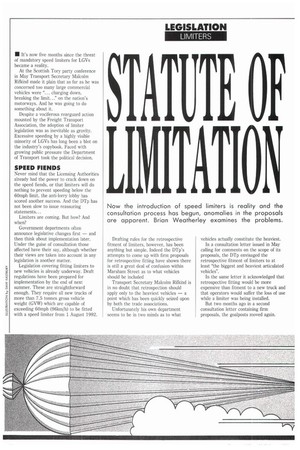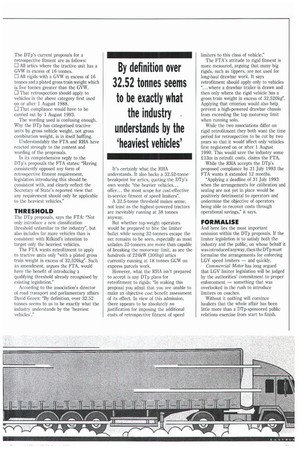STATUTE OF
Page 32

Page 33

If you've noticed an error in this article please click here to report it so we can fix it.
IMITATION Now the introduction of speed limiters is reality and the consultation process has begun, anomalies in the proposals are apparent. Brian Weatherley examines the problems.
By definition over 32.52 tonnes seems to be exactlly what the industry understands by the 'heaviest vehicles'
• It's now five months since the threat of mandatory speed limiters for LGVs became a reality.
At the Scottish Tory party conference in May Transport Secretary Malcolm Rifkind made it plain that as far as he was concerned too many large commercial vehicles were "... charging down, breaking the limit..." on the nation's motorways. And he was going to do something about it.
Despite a vociferous rearguard action mounted by the Freight Transport Association, the adoption of limiter legislation was as inevitable as gravity. Excessive speeding by a highly visible minority of LGVs has long been a blot on the industry's copybook, Faced with growing public pressure the Department of Transport took the political decision.
SPEED FIENDS
Never mind that the Licensing Authorities already had the power to crack down on the speed fiends, or that limiters will do nothing to prevent speeding below the 60mph limit, the anti-lorry lobby has scored another success. And the DTp has not been slow to issue reassuring statements...
Limiters are coming. But how? And when?
Government departments often announce legislative changes first — and then think about implementation later. Under the guise of consultation those affected have their say, although whether their views are taken into account in any legislation is another matter.
Legislation covering fitting limiters to new vehicles is already underway. Draft regulations have been prepared for implementation by the end of next summer. These are straightforward enough. They require all new trucks of more than 7.5 tonnes gross vehicle weight (GVW) which are capable of exceeding 60mph (96km/h) to be fitted with a speed limiter from 1 August 1992. Drafting rules for the retrospective fitment of limiters, however, has been anything but simple. Indeed the DTp's attempts to come up with firm proposals for retrospective fitting have shown there is still a great deal of confusion within Marsham Street as to what vehicles should be included Transport Secretary Malcolm Rifkind is in no doubt that retrospection should apply only to the heaviest vehicles — a point which has been quickly seized upon by both the trade associations.
Unfortunately his own department seems to be in two minds as to what vehicles actually constitute the heaviest.
In a consultation letter issued in May calling for comments on the scope of its proposals, the DTp envisaged the retrospective fitment of limiters to at least the biggest and heaviest articulated vehicles".
In the same letter it acknowledged that retrospective fitting would be more expensive than fitment to a new truck and that operators would suffer the loss of use while a limiter was being installed.
But two months ago in a second consultation letter containing firm proposals, the goalposts moved again. The DTp's current proposals for a retrospective fitment are as follows: 0 All artics where the tractive unit has a GVW in excess of 16 tonnes.
Cl All rigids with a GVW in excess of 16 tonnes and a plated gross train weight which is five tonnes greater than the GVW. LI That retrospection should apply to vehicles in the above category first used on or after 1 August 1988.
0 That compliance would have to be carried out by 1 August 1993.
The wording used is confusing enough. Why the DTp has categorised tractive units by gross vehicle weight, not gross combination weight, is in itself baffling.
Understandably the FTA and RHA have reacted strongly to the content and wording of the proprosals.
In its comprehensive reply to the Dip's proposals the FTA states: "Having consistently opposed any form of retrospective fitment requirement, legislation introducing this should be consistent with, and clearly reflect the Secretary of State's reported view that any requirement should only be applicable to the heaviest vehicles."
THRESHOLD
The DTp proposals, says the FTA: "Not only introduce a new classification threshold unfamiliar to the industry", but also includes far more vehicles than is consistent with Rifkind's intention to target only the heaviest vehicles.
The FTA wants retrofitment to apply to tractive units only "with a plated gross train weight in excess of 32,520kg". Such an amendment, argues the FTA, would have the benefit of introducing a qualifying threshold already recognised by existing legislation."
According to the association's director of road transport and parliamentary affairs David Green: "By definition, over 32.52 tonnes seems to us to be exactly what the industry understands by the "heaviest vehicles'." It's certainly what the RHA understands. It also backs a 32.52-tonne breakpoint for artics, quoting the DTp's own words: "the heavier vehicles... offer.., the most scope for cost-effective in-service fitment of speed limiters".
A 32.5-tonne threshold makes sense, not least as the highest-powered tractors are inevitably running at 38 tonnes anyway.
But whether top-weight operators would be prepared to bite the limiter bullet while seeing 32-tonners escape the net remains to be seen, especially as most unladen 32-tonners are more than capable of breaking the motorway limit, as are the hundreds of 224kW (300hp) artics currently running at 18 tonnes GCW on express parcels work.
However, what the RHA isn't prepared to accept is any DTp plans for retrofitment to rigids: "In making this proposal you admit that you are unable to make an objective cost benefit assessment of its effect. In view of this admission, there appears to be absolutely no justification for imposing the additional costs of retrospective fitment of speed limiters to this class of vehicle."
The FTA's attitude to rigid fitment is more measured, arguing that many big rigids, such as tippers, are not used for long-haul drawbar work. It says retrofitment should apply only to vehicles "...where a drawbar trailer is drawn and then only where the rigid vehicle has a gross train weight in excess of 32,520kg". Applying that criterion would also help prevent a high-powered drawbar chassis from exceeding the top motorway limit when running solo_ While the two associations differ on rigid retrofitment they both want the time period for retrospection to be cut by two years so that it would affect only vehicles first registered on or after 1 August 1990. This would save the industry some £13m in retrofit costs, claims the FTA.
While the RHA accepts the DTp's proposed compliance by 31 July 1993 the FTA wants it extended 12 months.
"Applying a deadline of 31 July 1993 when the arrangements for calibration and sealing are not yet in place would be positively detrimental to operators and undermine the objective of operators being able to recover costs through operational savings," it says.
FORMALISE
And here lies the most important omission within the DTp proposals. If the limiter legislation is to satisfy both the industry and the public, on whose behalf it was introduced anyway, then the DTp must formalise the arrangements for enforcing LGV speed limiters — and quickly.
Commercial Motor has long argued that LGV limiter legislation will be judged by the authorities' commitment to proper enforcement — something that was overlooked in the rush to introduce limiters on coaches.
Without it nothing will convince hauliers that the whole affair has been little more than a Dip-sponsored public relations exercise from start to finish.












































































